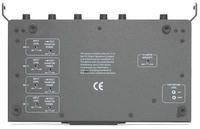XLR Inputs
 There are four balanced XLR MIC/LINE inputs on the left side (input side) of the mixer. (Although earlier units were labeled as Mic 1 thru Mic 4, in actuality these inputs are switchable for either MIC LEVEL or LINE LEVEL inputs. The term "Mic" was used informally to differentiate inputs from outputs.)
There are four balanced XLR MIC/LINE inputs on the left side (input side) of the mixer. (Although earlier units were labeled as Mic 1 thru Mic 4, in actuality these inputs are switchable for either MIC LEVEL or LINE LEVEL inputs. The term "Mic" was used informally to differentiate inputs from outputs.)
On the bottom of the mixer are four sets of sliding switches. They allow you to set each input for either mic or line, and to activate 48volt Phantom power for each mic. (Use the tip of a paper clip or the point of a pen to move the recessed sliding switches.)
 Keep the Phantom switch turned OFF except when you specifically need it to power condenser mics. Although the presence of Phantom power will not interfere with normal audio signals, it could increase the drain on your batteries and may have a long-term effect on some input devices (rare, but it has been known to happen).
Keep the Phantom switch turned OFF except when you specifically need it to power condenser mics. Although the presence of Phantom power will not interfere with normal audio signals, it could increase the drain on your batteries and may have a long-term effect on some input devices (rare, but it has been known to happen).
In case you ever get confused about XLR inputs and outputs, always remember that the connectors mimic basic biology. Audio signals always flow out of the male pins and into the female openings. So the XLR connector with pins is an OUTPUT. The XLR connector with the 3 holes is an INPUT.
For example, the bottom of your microphone is always an XLR male, since the signal goes out of the mic to whatever the mic is plugged into. The end of your mic cable that connects to the mic will always be a female, since the MIC output travels to an input. At the far end of that same mic cable will be another male connector. The signal exits the cable via the male, and then plugs into the female XLR of your mixer or recorder. Always, out of the male, into the female.
 Another common area of confusion for some folks is the difference between MIC LEVEL and LINE LEVEL. Mic level is a very faint signal, generated by the basic components of a microphone. Line level, on the other hand, is a relatively stronger signal that has been amplified by the active electronics of a mixing panel or playback device (such as a tape deck, CD/DVD player, etc.)
Another common area of confusion for some folks is the difference between MIC LEVEL and LINE LEVEL. Mic level is a very faint signal, generated by the basic components of a microphone. Line level, on the other hand, is a relatively stronger signal that has been amplified by the active electronics of a mixing panel or playback device (such as a tape deck, CD/DVD player, etc.)
There is approximately 55dB difference in gain (volume) between mic level and line level. Think in terms of two light bulbs, one is 12v and the other is 117v. If you send 117v of electricity into the 12v bulb, it will glow super bright (and will burnout). On the other hand, if you send only 12v to the 117v bulb, it will barely glow.
It is kind of like that with audio. If you send a powerful LINE OUTPUT signal into a MIC INPUT, the resulting audio will be very loud and distorted. If you send a weak MIC OUTPUT into a LINE INPUT, the audio will be very low and almost inaudible.
So the key is to match MIC to MIC and LINE to LINE. When plugging your mics into a mixer or camcorder, always select the MIC LEVEL INPUT. However, if you are taking a feed from a house mixing board (or PA system), or from a playback deck – then you want to select LINE LEVEL INPUT.
It is okay on the ENG 44 to use some of your inputs for mics, while simultaneously using your remaining inputs for LINE. That is why each input is individually switchable.
One more note. You purchased a mixer in order to get good audio. So use some good mics with it.
In my personal experience, I have found that trying to stick XLR adapters (and certainly never a daisy chain of multiple adapters) onto consumer grade, unbalanced (1/4-inch or mini-plug) mics is never a wise idea. Sometimes it will work but, more often than not, the results will be pretty disappointing due to a myriad of electronic reasons (such as impedance, grounding, polarity, and the fact that they are cheap mics to begin with).
